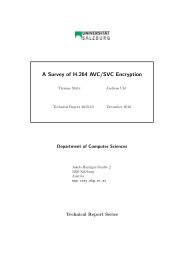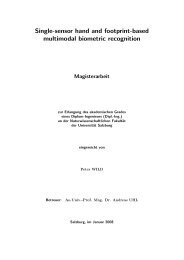Pit Pattern Classification in Colonoscopy using Wavelets - WaveLab
Pit Pattern Classification in Colonoscopy using Wavelets - WaveLab
Pit Pattern Classification in Colonoscopy using Wavelets - WaveLab
Create successful ePaper yourself
Turn your PDF publications into a flip-book with our unique Google optimized e-Paper software.
5 Results<br />
<strong>Pit</strong> <strong>Pattern</strong> Type I II III-L III-S IV V<br />
I 47 21 7 4 17 3<br />
II 45 14 12 5 19 4<br />
III-L 14 5 42 10 24 5<br />
III-S 0 8 17 33 33 8<br />
IV 21 10 15 13 25 15<br />
V 8 12 4 4 24 48<br />
Table 5.20: Result distribution matrix for CCLDB for 6 classes (<strong>Pit</strong> pattern images)<br />
pit pattern type has a classification rate exceed<strong>in</strong>g 48%. But as already mentioned above,<br />
this method does not suffer from low classification rates for pit pattern types II, III-S and V<br />
compared to the other pit pattern types, as shown <strong>in</strong> table 5.20.<br />
Us<strong>in</strong>g this method with the outex images resulted <strong>in</strong> good results, at least for the two<br />
classes case, as shown <strong>in</strong> table 5.4. For the two classes case the best overall result was 85%,<br />
which is the worst result for outex tests compared to all other methods. In the six classes<br />
case the results are even worse. The best result obta<strong>in</strong>ed here is only 49% which is a fairly<br />
bad result compared to all previous methods as shown <strong>in</strong> table 5.5.<br />
<strong>Pit</strong> <strong>Pattern</strong> Type Non-Neoplastic Neoplastic<br />
Non-Neoplastic 86 14<br />
Neoplastic 16 84<br />
Table 5.21: Result distribution matrix for CCLDB for 2 classes (Outex images)<br />
Class 1 2 3 4 5 6<br />
1 65 0 13 5 3 13<br />
2 12 47 10 5 22 4<br />
3 19 4 38 6 22 11<br />
4 6 0 8 54 15 17<br />
5 1 11 6 7 58 17<br />
6 3 3 9 8 45 32<br />
Table 5.22: Result distribution matrix for CCLDB for 6 classes (Outex images)<br />
From table 5.21 we see that the classification rates and therefore the misclassification rates<br />
for the two classes <strong>in</strong> the two classes case are nearly identical. In the six classes case, as<br />
depicted <strong>in</strong> table 5.22, we see that although the highest classification rates for the classes<br />
are located on the ma<strong>in</strong> diagonal, almost any other entry <strong>in</strong> the table conta<strong>in</strong>s a value greater<br />
than 0, which results <strong>in</strong> a bad classification result for each s<strong>in</strong>gle class, and thus <strong>in</strong> a fairly<br />
bad total classification result.<br />
90








